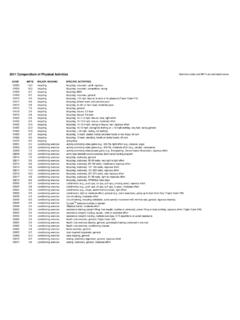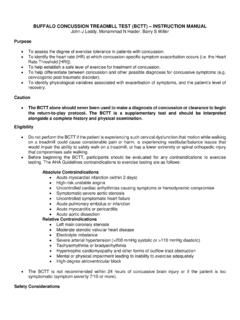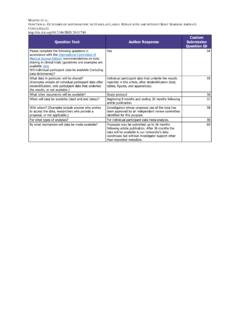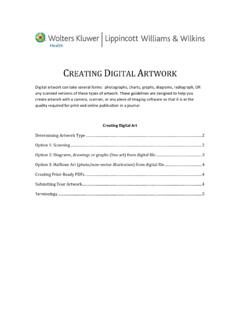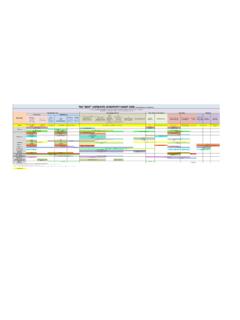Transcription of The following content was supplied by the authors as ...
1 COPYRIGHT BY THE JOURNAL OF BONE AND JOINT SURGERY, INCORPORATED YAO ET AL. ORAL AND IV ANTIBIOTIC ADMINISTRATION AFTER SINGLE-STAGE REVISION SHOULDER ARTHROPLASTY. STUDY OF SURVIVORSHIP AND PATIENT-REPORTED OUTCOMES IN PATIENTS WITHOUT CLEAR PREOPERATIVE OR INTRAOPERATIVE INFECTION Page 1 The following content was supplied by the authors as supporting material and has not been copy-edited or verified by JBJS. Appendix 1. Patient demographics, intraoperative findings, and microbiologic results by those included in this study vs. those lost to follow-up. Variable Total sent surveys (n=148) Included (n=92) Lost to follow-up (n=56) p-value Patient Demographics Median age (IQR, years) ( ) ( ) ( ) Male sex 85 (57%) 53 (58%) 32 (57%) Median BMI (IQR, kg/m2) ( ) ( ) ( ) ASA class 1 6 (4%) 5 (6%) 1 (2%) 2 76 (51%) 54 (59%) 22 (39%) 3 66 (45%) 33 (36%) 33 (59%) Smoker 15 (10%) 7 (8%) 8 (14%) Diabetic 21 (14%) 12 (13%) 9 (16%) Median pre-op VAS pain (IQR) 7 (6 8) 7 (6 8) 8 (6 8) Median pre-op SST score (IQR) 2 (1 4) 3 (1 6) 2 (0 3) Prior revision arthroplasty 27 (18%) 15 (16%)
2 12 (21%) Prior infection in same shoulder 18 (12%) 12 (13%) 6 (11%) Radiographic Findings Radiographic glenoid loosening 35/87 (40%) 24/57 (42%) 11/30 (37%) Radiographic humeral loosening 18 (12%) 13 (14%) 5 (9%) Intra-operative Details Intra-op glenoid loosening 42 (48%) 27/57 (47%) 15/30 (50%) Intra-op humeral loosening 33 (22%) 23 (25%) 10 (18%) Surgery type Partial single-stage exchange 17 (11%) 13 (14%) 4 (7%) Complete single-stage exchange 131 (89%) 79 (86%) 52 (93%) Antibiotic Protocol Yellow Protocol 89 (60%) 55 (60%) 34 (61%) Red Protocol 59 (40%) 37 (40%) 22 (39%) Microbiologic Results Median number of deep cultures taken (IQR) 6 (5 8) 6 (5 8) 6 (5 -8) Median number of deep cultures positive for Cutibacterium (IQR) 1 (0 3) 1 (0 3) 1 (0 3) Chi Square, Fisher Exact, and Kruskal Wallis tests used for significance testing.
3 IQR = interquartile range; BMI = body mass index; ASA = American Society of Anesthesiologists; SST = Simple Shoulder Test; TSA = Total Shoulder Arthroplasty; ShCuS = Shoulder Cutibacterium Score; ShBaS = Shoulder Bacterial Score. COPYRIGHT BY THE JOURNAL OF BONE AND JOINT SURGERY, INCORPORATED YAO ET AL. ORAL AND IV ANTIBIOTIC ADMINISTRATION AFTER SINGLE-STAGE REVISION SHOULDER ARTHROPLASTY. STUDY OF SURVIVORSHIP AND PATIENT-REPORTED OUTCOMES IN PATIENTS WITHOUT CLEAR PREOPERATIVE OR INTRAOPERATIVE INFECTION Page 2 Appendix 2. Additional methodological details. Antibiotic Protocols If the operating surgeon s suspicion for periprosthetic infection as defined by two or more positive cultures of the same bacterial species was high, patients were initiated on the Red Protocol.
4 The Red Protocol was typically selected if multiple preoperative and intraoperative observations ( , male sex, humeral osteolysis and loosening, glenoid wear, cloudy fluid, and membrane formation) suggested a higher risk of positive intraoperative cultures as reported previously. These patients received IV antibiotics through a peripherally inserted central catheter (PICC) inserted while the patient was hospitalized. IV antibiotics were discontinued at 21 days if cultures were negative but were continued for a total of 6 weeks if two or more positive deep cultures of the same species were obtained. If Cutibacterium was the sole species detected, then the drug of choice was ceftriaxone 2 grams IV every 24 hours.
5 Patients unable to receive ceftriaxone received either IV Vancomycin (targeting a trough of 10-20 mcg/ml) or IV daptomycin (dosed at 8 mg/ml). If coagulase-negative Staphylococcus was the sole species detected, patients usually received IV Vancomycin (targeting a trough of 10-20 mcg/ml) or IV daptomycin (dosed at 8 mg/ml). Oral rifampin (600mg daily) was added if no major drug-drug interactions and no underlying liver disease are present. IV antibiotic treatment was followed by a minimum of 3 months of oral antibiotics (doxycycline or amoxicillin-clavulanate). If the operating surgeon s suspicion for positive deep cultures was low, patients were initiated on the Yellow Protocol.
6 Patients on the Yellow Protocol received oral antibiotics (doxycycline 100 mg twice daily or amoxicillin-clavulanate 875mg/125mg twice daily) until cultures results were finalized at 21 days. If two or more positive cultures of the same species were obtained, then the patient was switched to six weeks of IV antibiotics administered through a PICC inserted in the outpatient setting followed by a minimum of 3 months of oral antibiotics. If cultures at 21 days were negative, then antibiotics were discontinued. Tissue harvesting and culturing methodology. Tissue specimens were harvested with a sterile instrument and sent to our hospital laboratory. The samples were placed in a stomacher with saline, and the saline was streaked onto three different media and observed for 21 days.
7 Explanted components were vortexed with saline, and the saline was streaked in a similar fashion. All specimens were processed by the laboratory within one hour after surgery in a Class 2 laminar flow biological safety cabinet. Specimens were inoculated onto the following microbiological media: blood agar (trypticase soy agar with 5% sheep blood), chocolate agar, Brucella agar (with blood, hemin, and vitamin K), and brain-heart infusion broth. All media, with the exception of the Brucella agar, were incubated at 37 C with 5% CO2 for 21 days. Brucella agar plates are incubated anaerobically at 37 C for 21 days. Media were examined daily for growth visually but were only opened if growth was noted.
8 COPYRIGHT BY THE JOURNAL OF BONE AND JOINT SURGERY, INCORPORATED YAO ET AL. ORAL AND IV ANTIBIOTIC ADMINISTRATION AFTER SINGLE-STAGE REVISION SHOULDER ARTHROPLASTY. STUDY OF SURVIVORSHIP AND PATIENT-REPORTED OUTCOMES IN PATIENTS WITHOUT CLEAR PREOPERATIVE OR INTRAOPERATIVE INFECTION Page 3 Appendix 3. Additional surgical, antibiotic, and microbiological results. Additional Revision Surgery Seventeen patients required additional revision surgery. Using a hierarchy of indications for revision surgery, infection was the indication in 8 patients, periprosthetic fracture in 1, instability in 2, cuff failure in 1, component loosening in 2, glenoid wear (hemiarthroplasty) in 1, unexplained pain and stiffness in 2.
9 Microbiology Of the 8 patients undergoing an additional revision surgery in the Red protocol group, 5 patients had multiple positive deep cultures. Three of these patients were positive for Cutibacterium, one for coagulase negative Staphylococcus, and another for Corynebacterium. Of the 8 patients undergoing additional revision in the Yellow protocol group, 3 patients had multiple positive deep cultures. One patient was positive for Cutibacterium, one for coagulase negative Staphylococcus, and one for Staphylococcus aureus. Five patients had positive cultures at both the index revision surgery and the additional revision surgery. Of these, three of these had the same bacterial species.
10 Patients with a Single Positive Culture A sub-analysis of patients with only a single positive culture found 18 patients with a single positive culture. Two of these patients (11%) went on to revision. One was revised for humeral loosening after 2 years. This patient s single positive culture grew Bacillus species. The other required revision surgery for pain and stiffness that was positive for bacteria. This patient s single positive culture grew Kocuria and subsequent revision grew Cutibacterium. Serious Clinical Complications from Antibiotic Therapy In the Red positive patients, one developed serious renal toxicity and secondary hypertension, one had severe diarrhea negative for Clostridium difficile, one needed PICC line replacement.


